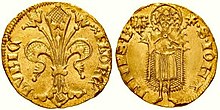Wendish Mint Association



As Wendischer coinage refers to the contractual merger northern German Hanseatic cities from 1379 to the 16th century for the purpose of uniform Münzregelungen.
The cities involved were mainly Lübeck , Hamburg , Wismar , Lüneburg and temporarily Rostock , Stralsund and Hanover . The basis was the Lübische Mark , from which coins called state marks were struck from 1506 to 1530 . Furthermore, a number of nominal coins with partial values of the Lübische Mark were minted:
- Witten for four pfennigs , quarter witten, hollow pfennig,
- Triplets , sextuplets, blafferte as well
- various shilling coins .
Lüneburg also coined the so-called Wendentaler , which was also valid in the Münzverein.
The common symbol on the coins was a six-pointed star in the middle of a cross. This symbol was subsequently imitated by many cities in Mecklenburg , Pomerania and Holstein , without them belonging to the Wendish Mint Association.
A similarly functioning coin union was the Rheinische Münzverein .
After the Augsburg Imperial Coin Order of 1566 and the formation of the Lower Saxony Coin Circle, the cities that were united in the Wendish Coin Association also accepted the taler currency. The mint day of February 7, 1569 was probably the last of the Wendish mint. In the district regulations for coinage of 1568 and 1572, coinage was carried out according to the new provisions, with the result that the federal government dissolved itself.
See also
literature
- Wilhelm Jesse : The Wendish Mint Association. Reprint with supplements and improvements, Braunschweig 1967. VIII S., 1 Bl., 322 S., 37 plates.
